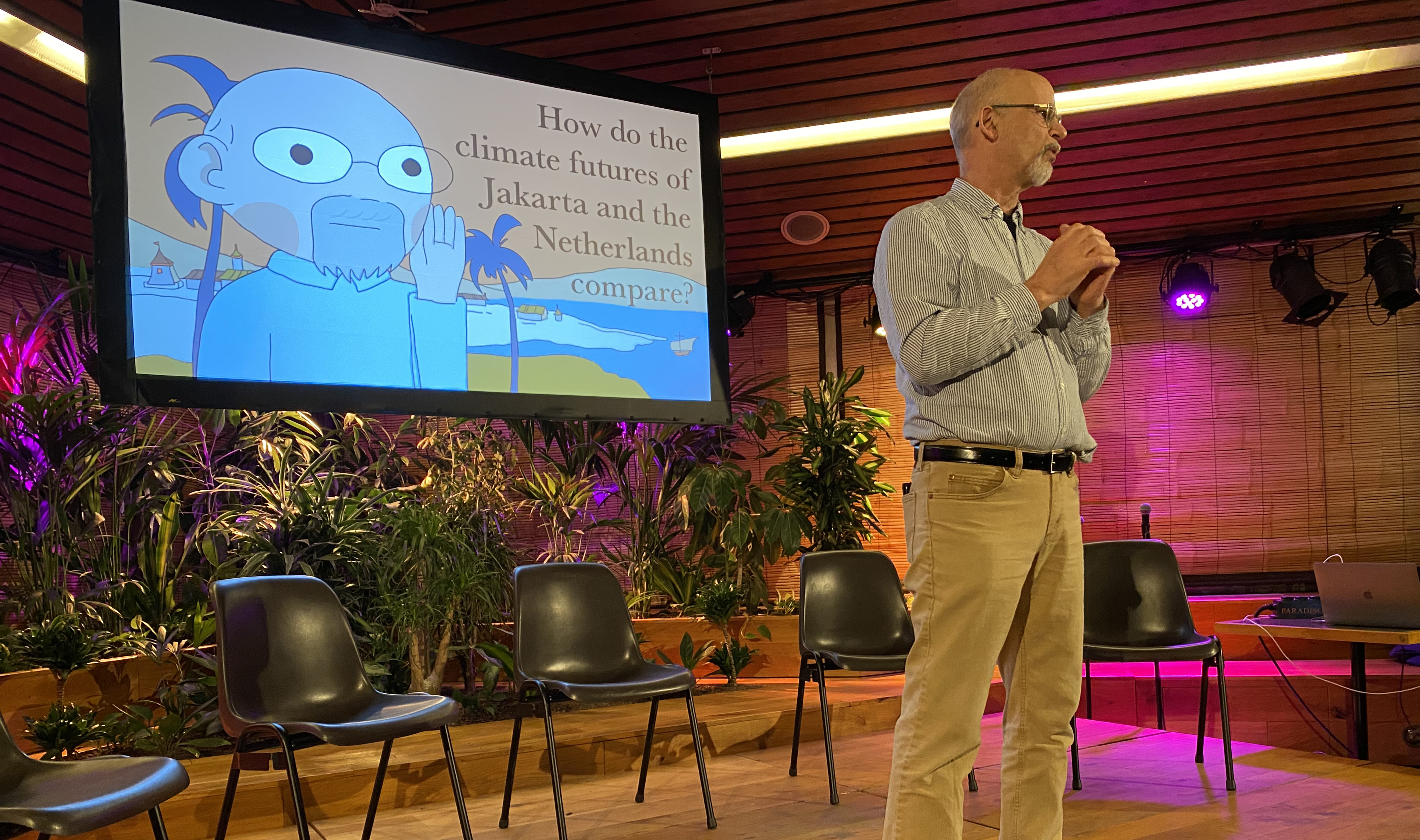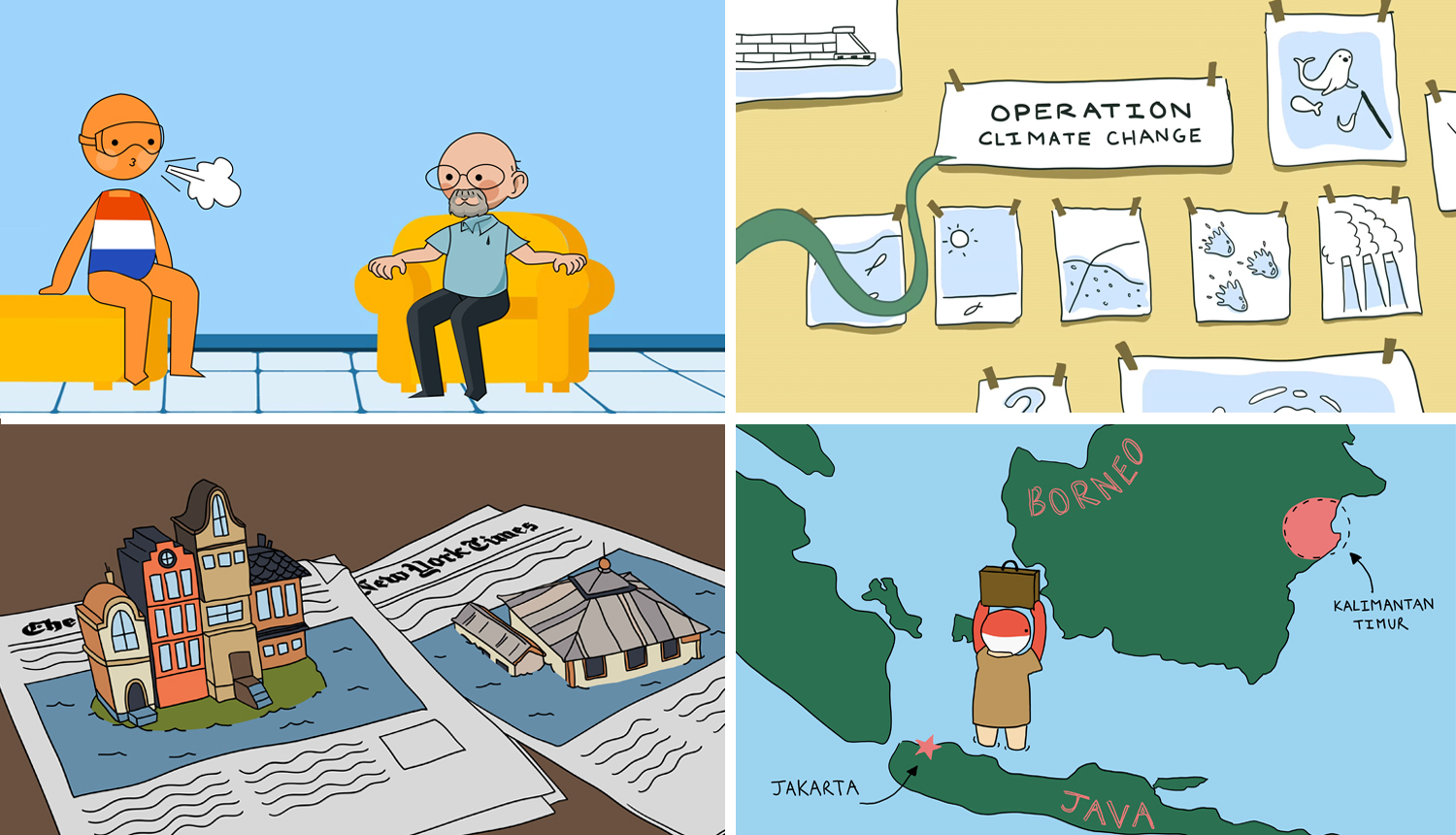Imagine a giant drained swimming pool. Now imagine one-quarter of the Netherlands inside that pool, as deep as 22 feet below sea level at its lowest points. Massive storm surge barriers, dikes, and 24/7 water pumps protect the country from flooding. However, with the intensification of climate change and the possibility of a sea-level rise of up to 16.4 feet by 2150, the Dutch may not be able to keep the swimming pool drained, says Simon Richter, Class of 1942 Endowed Term Professor of Germanic Studies.
To spread the word about this impending challenge, Richter—in partnership with Joshua Mosley, Professor of Fine Arts, and students—has created four animated videos over the past year and a half that examine the potential effects of sea-level rise in the Netherlands and Jakarta.
The guide in the climate videos is Richter’s animated alter ego, Professor Poldergeist. The name is a comedic play on polders, low-lying tracts of land that form an artificial hydrological entity enclosed by dikes, and an angry ghost or poltergeist. Richter says his Professor Poldergeist is “animated by the spirit of the Dutch polder,” alluding to an old story about a man who became overconfident about his ability to prevent flooding in his community, lost his entire family, and became a ghost that haunts the area.
“There’s a lesson in that ghost story,” explains Richter. “The Netherlands is, you could say, haunted by the success of its technology. Higher dikes and more pumps have served them in the past, but they may not work for much longer.”
The Dutch have been innovative and successful in using technology to protect their communities from flooding. However, because they created the polders, says Richter, they must now pump out water 24/7, which continues to cause the country to sink; the pumping exposes peat (an accumulation of partially decayed vegetation or organic matter) to air, which then oxidizes and releases greenhouse gases. This further causes sinking as the peat becomes denser.
“Once you add in an accelerated sea-level rise, the difference just grows to the point where it’s conceivable that within the next few decades or by the end of the century, the ability of the Dutch to keep pace with sea-level rise will be overwhelmed,” says Richter. The same is true and potentially happening much sooner in Indonesia’s capital city of Jakarta, home to more than 10.5 million people and the largest former Dutch colony in the world.
The mission of the Professor Poldergeist videos is to use animation, science, and a dose of humor to inform both the water sector and the public at large about the effect of accelerated sea-level rise on the Netherlands, and to contribute to public debate about how best to adapt there and elsewhere. The videos started as a collaboration with a team of three interns funded first by the Penn Undergraduate Research Mentoring Program, and later by the Sachs Program for Arts Innovation. The project has since been awarded a School of Arts & Sciences Making a Difference in Global Communities grant, given to support multidisciplinary projects working with students to address societal challenges internationally.
Richter and his team released their first video, “How Much of the Netherlands Is Below Sea Level?” on September 21, 2021, on YouTube. The government had claimed the answer was more than 50 percent. Some thought it was even higher, though the actual answer is 26 percent. More than 8,000 people have viewed the video.
Almost 5,000 people have watched the second video, which focuses on the current disconnect between accelerated sea-level rise and the Netherlands’ plan to build close to a million new housing units in the next 10 years, many in vulnerable areas. Viewers of the videos have included the director of innovation in the Department of Engineering for the city of Amsterdam and the Netherlands’ Delta Commissioner (who makes an animated appearance in the third video, about how the Netherlands might defend itself against climate change).
As a result of the videos, Richter has appeared in a Dutch documentary, spoken on national public radio, and been invited to do keynote speeches at universities and conventions of water professionals in the Netherlands. The latest video in the series, “How Do the Climate Futures of Jakarta and the Netherlands Compare?” was released in March 2023 in Amsterdam, “with more than 100 people in attendance for the premiere, followed by a panel discussion with leading figures in the Dutch and international climate adaptation space,” says Richter. The video explores why parts of Jakarta could be under water in 10 years, its complicated colonial history with the Dutch, moving the capital city to another island, and the surprising conclusion that Jakarta and the Netherlands don’t differ as much as people think.
“Jakarta and the Netherlands face the same dilemma, which is how to involve policymakers and millions of people in planning conversations that include the possibility of the mass relocation of people. Where will they go? Who will pay for it? How can livelihoods be assured?” says Professor Poldergeist in the video. “Neither country has a handle on climate change, and both should prepare for amphibious futures. They can learn from each other and from their citizen action groups and should be champions of renewable energy.”
This summer, Richter and Mosley are taking four Penn undergraduates—Lilian Liu, C'24; Katherine Li, ENG'26; Melody Kuo, C'24; and Annabel Sumardi, C'25—along with College 2023 graduates Cecily Nishimura and Justine Seo, to the Netherlands with support from Penn Global, Penn Arts & Sciences, the Stuart Weitzman School of Design, and the Sachs Program for Arts Innovation. They will tour the landscape and meet with climate experts. They plan to release two or three more Professor Poldergeist videos by summer’s end. Richter and Mosley also created an undergraduate course on environmental animation, which they taught this past spring.
“Our animated videos are an example of how the arts and the sciences can come together to affect policy—and that’s really important and powerful,” says Richter.




